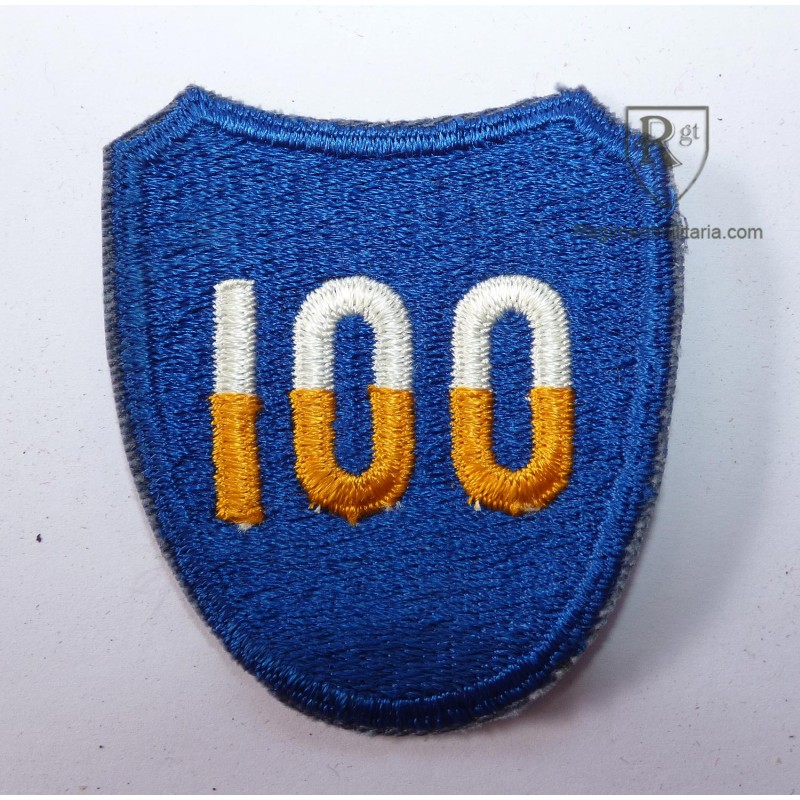

Banner

Banner




100th Infantry Division Patch. original, WW2.
 Garanties sécurité
Garanties sécurité
(à modifier dans le module "Réassurance")
 Politique de livraison
Politique de livraison
(à modifier dans le module "Réassurance")
 Politique retours
Politique retours
(à modifier dans le module "Réassurance")
Genuine WWII issue shoulder sleeve insignia of the 100th Infantry Division.
From late 1943 to early 1944, the division trained in the mountains of Tennessee and was then sent to Fort Bragg, North Carolina for further training. While at Fort Bragg, Technical Sergeant Walter L. Bull earned the first Expert Infantryman Badge. As soon as the division was prepared for combat, it began moving into the Meurthe-et-Moselle region, sending its first elements into combat at St. Remy in the Vosges Mountains on 1 November 1944. The division as a whole began the relief of the 45th Infantry Division at Baccarat on 5 November and took control of the sector by 9 November. The attack broke out on 12 November, and the division attacked the German winter line in the Vosges Mountains. The 100th took Bertrichamps and Clairupt, broke through the German line, and captured Raon-l'Étape and Saint-Blaise-Moyenmoutier between 16 and 26 November. Later in November, the division moved into the Vosges Mountains, with elements helping to hold the Saverne Gap bridgehead while the bulk of the division went into reserve. The unit was relieved from its assignment to VI Corps and transferred to the US XV Corps on 27 November 1944. It then moved to Moselle.
The Citadel of Bitche, France
In December 1944, the division went on the offensive in the vicinity of Bitche, France. The division occupied the nearby areas of Wingen and Lemberg after heavy fighting on 6 and 10 December. The division then advanced to Reyersviller, which fell after fighting from 11 to 13 December. On December 14, the 100th's regiments began their assault on a minor fortification Freundenburg and Fort Schiesseck, a major defensive work in the area. Fort Freundenburg was captured on December 17 by the 398th Infantry Regiment of the 100th Division. Fort Schiesseck surrendered after three more days of heavy assaults by the 100th on December 20. The division was ordered to halt its attack and hold defensive positions south of Bitche as part of the Seventh Army during the Battle of the Bulge. Thanks to a stout defense, the men of the 100th were later known as the "Sons of Bitche." German counterattacks on January 1 and 8–10, 1945, were repulsed, after heavy fighting at Bitche. After further attacks stalled and the Germans began to withdraw, the sector was generally quiet and the division prepared to resume its offensive to the east.
On 15 March 1945, the attack broke out and on 16 March Bitche fell to the 100th Infantry Division. The unit was subsequently relieved from its assignment to XV Corps and transferred to XXI Corps on 22 March 1945. Taking Neustadt and Ludwigshafen, the division reached the Rhine on 24 March. On 25 March 1945, the unit was returned from XXI Corps to VI Corps. On 31 March 1945, the 100th Infantry Division crossed the Rhine and moved south following the 10th Armored Division, then east across the Neckar River, establishing and expanding a bridgehead from 4 to 11 April. Heilbronn fell after nine days of house-to-house fighting on 12 April and the division resumed its rapid pursuit of the enemy, reaching Stuttgart on 21 April. The 100th was mopping up along the Neckar River southeast of Stuttgart on 23 April when it was withdrawn from VI Corps and assigned directly to the Seventh United States Army as an echelon above the corps. The division was then assigned primarily to patrolling the sector east of Stuttgart. Moving to Göppingen on 30 April, the division performed occupational duties as the war in Europe ended on V-E Day.
The division alone took 13,351 enemy prisoners of war. Members of the division earned three Medals of Honor, seven Distinguished Service Crosses, five Legions of Merit, 492 Silver Star Medals, 23 Soldier's Medals, 5,156 Bronze Star Medals, and 90 Air Medals. The division itself received three campaign streamers for its participation in the campaign.
The 100th Infantry Division returned to the United States via the Hampton Roads Port of Embarkation on 10 January 1946 and was mustered out of duty at Camp Patrick Henry, Virginia that day. The division then began the process of demobilization, before deactivating on 26 January
Reference: U2E810
Reference: U2E748
Reference: F1E419
Reference: ALG142

100th Infantry Division Patch. original, WW2.
check_circle
check_circle